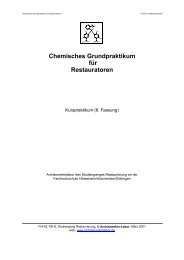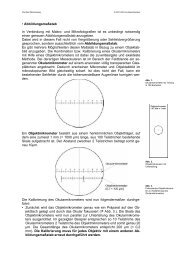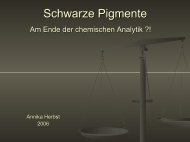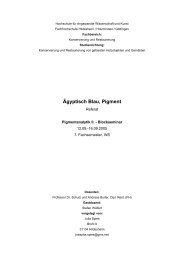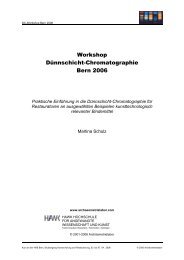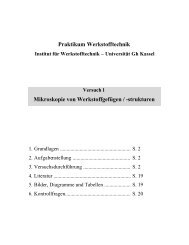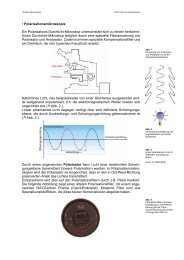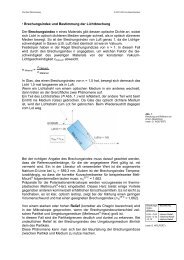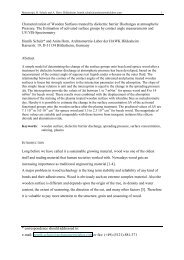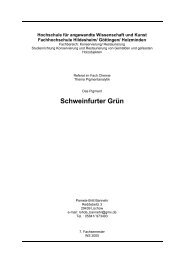Anita Horn and Henrik Schulz
Anita Horn and Henrik Schulz
Anita Horn and Henrik Schulz
You also want an ePaper? Increase the reach of your titles
YUMPU automatically turns print PDFs into web optimized ePapers that Google loves.
ESTIMATION OF THE RELIABILITY OF HANSEN-PARAMETERS OF PHOTOOXIDATIVE DEGRADED POLYMER FILMS<br />
BY CONTACT ANGLE MEASUREMENTS, by <strong>Anita</strong> <strong>Horn</strong> <strong>and</strong> <strong>Henrik</strong> <strong>Schulz</strong>, Hildesheim, Germany<br />
<strong>Anita</strong> <strong>Horn</strong> <strong>and</strong> <strong>Henrik</strong> <strong>Schulz</strong><br />
Archäometrie-Labor, Institut für Restaurierung<br />
Fachhochschule Hildesheim/Holzminden/Göttingen, D-31134 Hildesheim, Kaiserstr. 19<br />
www.archaeometrielabor.com<br />
INTRODUCTION AND BACKGROUND<br />
For many liquids an empirical correlation between cohesive energy density ε <strong>and</strong> surface tension γ is<br />
long since known [1]. Both quantities ε <strong>and</strong> γ are relative <strong>and</strong> therefore specific thermodynamic<br />
values. ε <strong>and</strong> γ are temperature-dependent parameters. The cohesive energy ∆E of a liquid is equal to<br />
the inner energy ∆UV of that liquid <strong>and</strong> can be calculated from the enthalpy of vaporization ∆HV <strong>and</strong><br />
the work that is required to exp<strong>and</strong> the vapor against the atmosphere (volume work) [2].<br />
∆E = ∆UV = ∆HV - RT (1)<br />
where T is the temperature in Kelvin <strong>and</strong> R is the gas constant.<br />
The cohesive energy ∆E related to the molar volume Vm of the liquid defines the quantity ε. Because<br />
the unit of ε is energy per volume the value is called cohesive energy density. Finally the solubility<br />
parameter δ (also known as HILDEBRAND-parameter) is the square root of the cohesive energy density<br />
ε:<br />
δ ε<br />
⎛ ∆H<br />
V ⎜<br />
1<br />
− RT ⎞ 2<br />
⎟<br />
(2)<br />
=<br />
=<br />
⎜<br />
⎝<br />
V<br />
m<br />
⎟<br />
⎠<br />
To describe the interaction between two different solvents A <strong>and</strong> B HILDEBRAND <strong>and</strong> SCOTT<br />
introduced a new cohesive energy density εAB of the pairs A⎯B on the interface region of the solvent<br />
mixture being equal to the geometric mean of the cohesive energy densities of the pure components<br />
[2,3]:<br />
AB<br />
1<br />
2<br />
( ε A ⋅ ε B ) = δ A δ B<br />
ε = ⋅<br />
(3)<br />
Equation (3) has remarkable consequences for the reliability of the whole framework of the solubility<br />
theory.<br />
1
ESTIMATION OF THE RELIABILITY OF HANSEN-PARAMETERS OF PHOTOOXIDATIVE DEGRADED POLYMER FILMS<br />
BY CONTACT ANGLE MEASUREMENTS, by <strong>Anita</strong> <strong>Horn</strong> <strong>and</strong> <strong>Henrik</strong> <strong>Schulz</strong>, Hildesheim, Germany<br />
The extension of the solubility parameter δ takes account of not only the dispersion forces (δ d), but<br />
also of the parts of the polar forces (δ p) <strong>and</strong> the contribution of the hydrogen bonds (δ h). It is<br />
expressed by the following summation:<br />
2<br />
2<br />
d<br />
2<br />
p<br />
2<br />
h<br />
δ = δ + δ + δ<br />
(4)<br />
HANSEN [4] was the first who introduced this extraordinary concept to locate the solubilities of<br />
polymers in organic solvents as points in a solubility parameter plot; a cube. By tuning <strong>and</strong> successive<br />
refining the positions of each of the 32 polymers <strong>and</strong> their solubilities in 60 different solvents Hansen<br />
was able to determine for each solvent the three components δ d, δ p <strong>and</strong> δ h of the HILDEBRAND-<br />
Parameter δ .<br />
The approximation of the interaction in the interfacial region by the method of geometric mean is<br />
crucial <strong>and</strong> leads up to the surface <strong>and</strong> interfacial tension γ. Using the GIBBS-HELMHOLTZ equation of<br />
the free energy G,<br />
dG = dH – TdS,<br />
where H is the enthalpy, S is the entropy <strong>and</strong> T the temperature, <strong>and</strong> in analogy for the interfacial<br />
region of an area A we get the thermodynamical expression for γ<br />
⎛ ∂G<br />
⎞<br />
⎜ ⎟<br />
⎝ ∂A<br />
⎠<br />
p,<br />
T , etc.<br />
≡<br />
γ<br />
More exactly the interfacial tension γ is named as specific free interfacial energy. The unit is [energy]<br />
per [surface area], i.e. abbreviated [mN⋅m -1 ].<br />
The interfacial tension γAB in any interfacial region of two adjacent phases (e.g. liquid-liquid or solid-<br />
liquid) was first predicted for nonpolar liquids <strong>and</strong> solids by the geometric mean of the dispersion<br />
force component of the interfacial tension of both of the materials A <strong>and</strong> B:<br />
⎜⎛<br />
d d<br />
⎟⎞<br />
+ ⎜⎛<br />
d d<br />
γ = −<br />
− ⎟⎞<br />
AB γ A γ Aγ<br />
B γ B γ Aγ<br />
B<br />
(6)<br />
⎝<br />
⎠ ⎝<br />
⎠<br />
where γ d A <strong>and</strong> γ d B is the part of the dispersion force of interfacial tension of the material A <strong>and</strong> B resp.,<br />
with γA <strong>and</strong> γB the total interfacial tension of the pure compounds A <strong>and</strong> B. Eq. (6) was first suggested<br />
by Fowkes [5] <strong>and</strong> validated for a series of nonpolar substances.<br />
(5)<br />
2
ESTIMATION OF THE RELIABILITY OF HANSEN-PARAMETERS OF PHOTOOXIDATIVE DEGRADED POLYMER FILMS<br />
BY CONTACT ANGLE MEASUREMENTS, by <strong>Anita</strong> <strong>Horn</strong> <strong>and</strong> <strong>Henrik</strong> <strong>Schulz</strong>, Hildesheim, Germany<br />
To realize the other contributions into the eq. (6) of the interfacial tension γAB the term can be<br />
extended in the same manner as given in the following equation (7)<br />
⎜⎛<br />
d d<br />
p p h h<br />
γ = + −<br />
+ + ⎟⎞<br />
AB γ A γ B 2 γ Aγ<br />
B γ Aγ<br />
B γ Aγ<br />
B<br />
(7)<br />
⎝<br />
⎠<br />
where the super indices d, p <strong>and</strong> h indicate the parts of the dispersion <strong>and</strong> polar forces <strong>and</strong> the<br />
hydrogen bonds respectively of the interfacial tension of the material A <strong>and</strong> B resp., where γA <strong>and</strong> γB<br />
are the total interfacial tension of the pure compounds A <strong>and</strong> B.<br />
Nevertheless of this straightforward <strong>and</strong> surely oversimplified method the calculation of the<br />
components of interfacial tension γ is possible. If material A is a solid (S), e.g. a polymer, <strong>and</strong> material<br />
B is a liquid (L) we can measure the contact angle Θ on the interface. The relation between γB = γL of<br />
the liquid, γA = γS of the polymer <strong>and</strong> γAB = γSL of the interfacial region on the surface is given by the<br />
YOUNG equation<br />
γ = γ + γ ⋅cosΘ<br />
(8)<br />
S<br />
L<br />
SL<br />
Rename the coefficients in eq. (7), substitute eq. (7) into eq. (8) <strong>and</strong> rearrange the term yields<br />
1<br />
2<br />
1<br />
2<br />
1<br />
d d<br />
p p<br />
h h<br />
γ L ( 1 + cosΘ)<br />
= ( γ L ) γ S + ( γ L ) γ S + ( γ L ) γ S<br />
(9)<br />
2<br />
For a set of test liquids with known components of total surface tension γL, which are tabulated e.g.<br />
[6,7],<br />
with<br />
L<br />
d<br />
L<br />
p<br />
L<br />
h<br />
L<br />
γ = γ + γ + γ<br />
(10)<br />
equation (9) forms a set of linear equations. The solutions are the components of the total surface<br />
tension γS of the polymer<br />
S<br />
d<br />
S<br />
p<br />
S<br />
h<br />
S<br />
γ = γ + γ + γ<br />
(10a)<br />
Using the results of eq. (10) <strong>and</strong> the YOUNG equation (8) we can calculated the interfacial tension γSL<br />
of the interfacial region. This procedure is also known as the Extended Fowkes method [8].<br />
1<br />
2<br />
3
ESTIMATION OF THE RELIABILITY OF HANSEN-PARAMETERS OF PHOTOOXIDATIVE DEGRADED POLYMER FILMS<br />
BY CONTACT ANGLE MEASUREMENTS, by <strong>Anita</strong> <strong>Horn</strong> <strong>and</strong> <strong>Henrik</strong> <strong>Schulz</strong>, Hildesheim, Germany<br />
Solubility δ <strong>and</strong> interfacial free energy γ are two manifestations of the same intermolecular forces<br />
between different substances. Therefore the parameters δS d , δS p <strong>and</strong> δS h should be reliable predicted by<br />
the interfacial free energy parameters γS d , γS p <strong>and</strong> γS h respectively <strong>and</strong> vice versa. The exact relation<br />
between<br />
δ ~ γ resp. δ = (const.)<br />
⋅γ<br />
2<br />
remains still unknown, but δ 2 <strong>and</strong> γ are of comparable magnitude. At the very beginning we shall set<br />
δ = γ , but are conscious of following the rather tenuous mathematical path. Nevertheless of this<br />
reduction the chemical changes up to the surface of artificially aged solids could be recognized <strong>and</strong><br />
sufficiently explained. Consequently we transcript the TEAS-parameter fd, fp <strong>and</strong> fh [9]<br />
f<br />
d<br />
δ d<br />
= 100<br />
δ + δ + δ<br />
d<br />
d<br />
p<br />
p<br />
h<br />
δ p<br />
f p = 100<br />
(12)<br />
δ + δ + δ<br />
f<br />
h<br />
δ h<br />
= 100<br />
δ + δ + δ<br />
d<br />
p<br />
h<br />
h<br />
into the tension-parameter td, tp <strong>and</strong> th of the aged surface of the tested solids (polymers)<br />
t<br />
t<br />
t<br />
d<br />
p<br />
h<br />
= 100<br />
γ<br />
d<br />
s<br />
d<br />
s<br />
+<br />
γ<br />
γ<br />
d<br />
s<br />
p<br />
s<br />
p<br />
s<br />
p<br />
s<br />
+<br />
γ<br />
h<br />
s<br />
= 100<br />
γ<br />
(13)<br />
γ + γ + γ<br />
=<br />
100<br />
γ<br />
d<br />
s<br />
+<br />
γ<br />
γ<br />
h<br />
s<br />
p<br />
s<br />
+<br />
γ<br />
h<br />
s<br />
h<br />
s<br />
(11)<br />
4
ESTIMATION OF THE RELIABILITY OF HANSEN-PARAMETERS OF PHOTOOXIDATIVE DEGRADED POLYMER FILMS<br />
BY CONTACT ANGLE MEASUREMENTS, by <strong>Anita</strong> <strong>Horn</strong> <strong>and</strong> <strong>Henrik</strong> <strong>Schulz</strong>, Hildesheim, Germany<br />
Experimental<br />
A maple veneered 3 mm – plywood carries a multi-layered finish, which is applied with a red sable<br />
hair brush. The layers are s<strong>and</strong>ed in between. Six different varnishes are used:<br />
∙ cold pressed linseed oil, natural<br />
∙ cold pressed linseed oil with a siccative (Manganese(II)acetylacetonate)<br />
∙ Cellulose nitrate (pure), dissolved in Acetone/Ethyl acetate, diluted with Ethanol to a 10% solution,<br />
butanol was added to improve the film formation<br />
∙ Dammar<br />
∙ bleached shellac, wax free<br />
∙ so called Button lac (raw shellac, washed)<br />
All of the natural resins are dissolved in Ethanol (10% solutions). The storage of the samples (size:<br />
100 x 40 mm) takes place in an exsiccator at room temperature <strong>and</strong> about 55 % relative humidity<br />
(above a saturated Magnesium nitrate hexahydrate solution) in darkness.<br />
One batch of samples are treated at a time by a mercury low pressure radiator (“Puritec” NSE 11-270<br />
G 23, Radium, Germany) with 90 %-emission at 254 nm <strong>and</strong> increased temperature ( 50 °C ± 4 °C).<br />
Humidity is not controlled. The storage time of the samples is for the first batch treated 11 <strong>and</strong> for the<br />
second one 12 weeks. The samples are irradiated at higher temperature for 16 hours (± 1 h) <strong>and</strong> stay<br />
for 8 hours (± 1 h) under room conditions. In this time contact angles are measured.<br />
Contact angle measurement occurs by the Sessile Drop Method with a video-based optical contact<br />
angle meter, equipped with an electronic syringe unit (OCA 15plus, DataPhysics Instruments GmbH,<br />
Germany). The measurement is carried out at room conditions. SCA 20 software, Version 1.6, is used<br />
to operate the instrument <strong>and</strong> to calculate contact angles as well as free surface energy of the solid<br />
samples.<br />
Settings :<br />
∙ Syringe type: Hamilton 1750 TLL (500 µl) used with a replaceable dosing needle<br />
with a inner diameter of 0.1 mm (Art.-No. 5132-1/4-B, GLT mbH, Germany)<br />
∙ Drop type: normal drop<br />
∙ Drop volume: 5 µl<br />
∙ Dosing rate: 4 µl/s<br />
∙ Frame grabbing time 10 s, 25 images/s (except measurements with n-decane:<br />
frame grabbing time 3 s, 50 images/s)<br />
∙ Calculation method for the sessile drop: circle fitting (neglects gravity)<br />
∙ Liquids: water, ethylene glycol <strong>and</strong> n-decane<br />
Each sample is measured 10 times at different spots, further calculations are based on the average of<br />
the results above.<br />
5
ESTIMATION OF THE RELIABILITY OF HANSEN-PARAMETERS OF PHOTOOXIDATIVE DEGRADED POLYMER FILMS<br />
BY CONTACT ANGLE MEASUREMENTS, by <strong>Anita</strong> <strong>Horn</strong> <strong>and</strong> <strong>Henrik</strong> <strong>Schulz</strong>, Hildesheim, Germany<br />
RESULTS AND DISCUSSION<br />
The summarized values in table 1 together with the contact angles Θ in table 2 enable to calculate the<br />
contributions of dispersion forces γS d , polar forces γS p <strong>and</strong> hydrogen bonding γS h to the total interfacial<br />
free energy.<br />
TAB. 1: Set of test liquids (L) <strong>and</strong> their total surface tension γL <strong>and</strong> contributions γL d , γL p <strong>and</strong> γL h ,<br />
in units of [mN/m] (see eq.(10))<br />
Ref. test liquid (L) γL γL d γL p γL h<br />
[8]<br />
[8]<br />
[6]<br />
Water (A)<br />
ethylene glycol (B)<br />
n-decane (C)<br />
72,80 ± 0,05<br />
47,70<br />
23,83 ± 0,10<br />
29,10<br />
30,90<br />
23,83<br />
1,30<br />
0<br />
0<br />
42,40<br />
17,60<br />
0<br />
TAB. 2: Average value of contact angles θ of the three test liquids on different surface materials<br />
<strong>and</strong> results of the calculation by the method of Extended Fowkes (see. eq. (9))<br />
Cellulose<br />
nitrate<br />
ageing [h] θA θB θC γS d γS p γS h<br />
0<br />
16<br />
33<br />
49<br />
Shellac 0<br />
16<br />
33<br />
49<br />
Dammar 0<br />
16<br />
33<br />
49<br />
Linseed Oil,<br />
cold pressed<br />
0<br />
16<br />
33<br />
49<br />
76,9 ± 0,4<br />
47,7 ± 3,4<br />
24,9 ± 0,8<br />
23,9 ± 0,7<br />
66,3 ± 0,7<br />
65,6 ± 0,1<br />
65,7 ± 1,8<br />
54,0 ± 1,1<br />
69,2 ± 0,5<br />
52,9 ± 0,7<br />
24,9 ± 0,7<br />
37,8 ± 7,6<br />
92,3 ± 1,9<br />
81,9 ± 0,9<br />
78,2 ± 1,5<br />
75,2 ± 1,6<br />
49,4 ± 0,8<br />
31,9 ± 3,8<br />
17,8 ± 0,7<br />
19,1 ± 1,0<br />
36,3 ± 1,0<br />
37,6 ± 0,4<br />
37,8 ± 1,0<br />
33,2 ±1,6<br />
56,8 ± 0,5<br />
20,1 ± 0,7<br />
23,3 ± 0,5<br />
29,1 ±1,6<br />
77,4 ± 1,3<br />
58,5 ± 0,5<br />
55,1 ± 0,3<br />
55,1 ±1,1<br />
8,2 ± 1,2<br />
7,7 ± 0,6<br />
6,3 ± 0,5<br />
7,6 ±0,2<br />
8,3 ± 0,4<br />
8,6 ± 0,3<br />
7,9 ± 0,7<br />
11,9 ±1,3<br />
8,4 ± 0,4<br />
7,0 ± 0,4<br />
7,8 ± 0,9<br />
9,4 ±0,4<br />
7,7 ± 0,1<br />
5,7 ± 0,4<br />
6,6 ± 0,5<br />
6,1 ±0,1<br />
23,51<br />
23,62<br />
23,65<br />
23,61<br />
23,54<br />
23,57<br />
23,58<br />
23,48<br />
23,59<br />
23,63<br />
23,61<br />
23,54<br />
22,76<br />
23,39<br />
23,43<br />
23,48<br />
2,18<br />
25,47<br />
72,07<br />
117,58<br />
0,24<br />
5,17<br />
4,32<br />
11,66<br />
40,95<br />
1,2<br />
108,19<br />
94,54<br />
55,14<br />
53,63<br />
34,65<br />
61,17<br />
9,65<br />
19,15<br />
21,62<br />
22,53<br />
13,66<br />
15,11<br />
15,17<br />
18,02<br />
23,39<br />
22,05<br />
21,49<br />
20,47<br />
0,07<br />
1,34<br />
3,72<br />
3,37<br />
6
ESTIMATION OF THE RELIABILITY OF HANSEN-PARAMETERS OF PHOTOOXIDATIVE DEGRADED POLYMER FILMS<br />
BY CONTACT ANGLE MEASUREMENTS, by <strong>Anita</strong> <strong>Horn</strong> <strong>and</strong> <strong>Henrik</strong> <strong>Schulz</strong>, Hildesheim, Germany<br />
The conditions of artificial ageing are very tough <strong>and</strong> intensive (moisture 50% r.h., temperature 50°C<br />
<strong>and</strong> short wave light 254 nm). The degradation on the surface of the chosen materials cellulose nitrate,<br />
shellac, dammar <strong>and</strong> linseed oil is obviously seen in the increase of the γS p values. In contrast to the<br />
strong time-dependence the changes of the polar forces represented by γS p the contribution of<br />
dispersion is remarkable constant <strong>and</strong> of unexpected magnitude. The dispersion forces of all of the<br />
investigated materials are in the range of about 20 mN m -1 . Obviously the ubiquity of the dispersion<br />
forces in any kind of matter are responsible for such consistent behavior. Dispersion forces exist in all<br />
types of matter <strong>and</strong> always give an attractive force between adjacent atoms or molecules no matter<br />
how dissimilar their chemical natures may be.<br />
So it might be possible to approximate the unknown volume element or molar volume of solids<br />
especially of the polymers. For instance the CH2 group in saturated hydrocarbons or the CH group in<br />
aromatics have nearly the same radius as the water molecule [5].<br />
parts of free surface energy [mN/m]<br />
Linseed Oil, cold pressed, calculated by Extended Fowkes Method<br />
40<br />
35<br />
30<br />
25<br />
20<br />
15<br />
10<br />
5<br />
0<br />
0 10 20 30 40 50<br />
duration of ageing [h]<br />
Disp.<br />
Polar<br />
H.H<br />
FIG. 1 Contribution of γS d (�), γS p (�) <strong>and</strong> γS h (π) to the total free surface energy γS of a film of<br />
linseed oil (air, light 254nm, 50% r.h. 50°C)<br />
The changes in γS p <strong>and</strong> γS h are better illustrated by graphs. Fig. 1 shows an interesting behavior of<br />
decreasing in the polar component <strong>and</strong> a slightly increase in the hydrogen bonding part of the free<br />
surface energy of the linseed oil film. Normally the polar forces <strong>and</strong> the free surface energy γS p<br />
increase during the ageing process. On the other h<strong>and</strong> the film seems to be stable to polar <strong>and</strong> unploar<br />
7
ESTIMATION OF THE RELIABILITY OF HANSEN-PARAMETERS OF PHOTOOXIDATIVE DEGRADED POLYMER FILMS<br />
BY CONTACT ANGLE MEASUREMENTS, by <strong>Anita</strong> <strong>Horn</strong> <strong>and</strong> <strong>Henrik</strong> <strong>Schulz</strong>, Hildesheim, Germany<br />
solvents. In comparison with natural aged linseed oil we calculated according eq. (13) the t-parameter<br />
<strong>and</strong> entered the values into Fig. 2 which was taken from the literature [10]. The only thing that fits is<br />
the appropriate location in the chart far away from the shown swelling regions of the natural aged film.<br />
FIG. 2 Swelling behavior of polymerised linseed oil films Contours at 60% swelling are shown<br />
for a film aged 27 weeks (⎯) <strong>and</strong> a film aged 14 years (—), data from Stolow [10];<br />
the t-parameter (see eq. (13)) of the own linseed oil film are entered: (�) untreated, (�)<br />
after 16 hours, (�) after 33 hours <strong>and</strong> (ρ) after 49 hours of ageing<br />
An example for a strong artificial aged material is cellulose nitrate which is illustrated in Fig. 3 <strong>and</strong> 4.<br />
The constant values of γS d <strong>and</strong> the moderate growth in γS h ist dominated of an extraordinary increase of<br />
the γS p at last over 100 mN m -1 .<br />
8
ESTIMATION OF THE RELIABILITY OF HANSEN-PARAMETERS OF PHOTOOXIDATIVE DEGRADED POLYMER FILMS<br />
BY CONTACT ANGLE MEASUREMENTS, by <strong>Anita</strong> <strong>Horn</strong> <strong>and</strong> <strong>Henrik</strong> <strong>Schulz</strong>, Hildesheim, Germany<br />
parts of free surface energy [mN/m]<br />
120<br />
100<br />
80<br />
60<br />
40<br />
20<br />
0<br />
Cellulose nitrate, calculated by Extended Fowkes Method<br />
Disp.<br />
Polar<br />
H.H<br />
-5 0 5 10 15 20 25 30 35 40 45 50 55<br />
duration of ageing [h]<br />
Fig. 3 Contribution of γS d (�), γS p (�) <strong>and</strong> γS h (π) to the total free surface energy γS of a film of<br />
cellulose nitrate (air, light 254nm, 50% r.h. 50°C)<br />
The well-known instability <strong>and</strong> photooxidative degradation of cellulose nitrate is yet visible during the<br />
last measurements (over 30 hours of ageing). The test liquids water <strong>and</strong> ethylene glycol dissolve the<br />
stressed cellulose nitrate rapidly. The calculated t-parameters (eq. (13)) are added into the solubility<br />
chart of a commercial cellulose nitrate (see Fig. 4).<br />
FIG. 4 Solubility of cellulose nitrate (CN), data (�)from Hansen [10];<br />
the t-parameter (see eq. (13)) of the own CN film are entered: (�) untreated, (�) after<br />
16 hours, (�) after 33 hours <strong>and</strong> (ρ) after 49 hours of ageing. The point (⊗) marks<br />
another solubility of CN (Ref [11]): δCN d =15.4, δCN p =14.7 <strong>and</strong> δCN h =8.8, <strong>and</strong> according eq.<br />
(12) fd=39.6, fp=37.8 <strong>and</strong> fh=22.6<br />
9
ESTIMATION OF THE RELIABILITY OF HANSEN-PARAMETERS OF PHOTOOXIDATIVE DEGRADED POLYMER FILMS<br />
BY CONTACT ANGLE MEASUREMENTS, by <strong>Anita</strong> <strong>Horn</strong> <strong>and</strong> <strong>Henrik</strong> <strong>Schulz</strong>, Hildesheim, Germany<br />
Only the untreated cellulose nitrate is behind the frontier of solubility. The following values of the tparameter<br />
clearly move in the direction of the strong polar region of the solubility chart. Fig. 3 <strong>and</strong> 4<br />
correspond with each other.<br />
As in Fig. 5 seen the dammar shows a more complex behavior of the changes in the parts of the<br />
attractive forces relating to the total interfacial tension γS. The contributions of the dispersion forces<br />
<strong>and</strong> the hydrogen bonding are the way as just developed in the examples of the linseed oil <strong>and</strong> the<br />
cellulose nitrate. Nearly constant in the amount of γS d <strong>and</strong> only a slightly increase in the γS h values<br />
during the ageing. Also the magnitude of these values are comparable with the two former discussed<br />
materials. In the case of the polar forces we are concerned about the reliability of the measured contact<br />
angles <strong>and</strong> the calculations. It is unlikely that the time depending function γS p = γS p (t) goes through a<br />
minimum, but rather the course is S-shaped <strong>and</strong> reaches a plateau. The assumption of such a S-shaped<br />
run of γS p (t) could be strengthened by calculations which make use of the harmonic mean method [7].<br />
parts of free surface energy [mN/m]<br />
100<br />
80<br />
60<br />
40<br />
20<br />
0<br />
Dammar, calculated by Extended Fowkes Method<br />
Disp.<br />
Polar<br />
H.H<br />
0 10 20 30 40 50<br />
duration of ageing [h]<br />
FIG. 5 Contribution of γS d (�), γS p (�) <strong>and</strong> γS h (π) to the total free surface energy γS of a film of<br />
dammar (air, light 254nm, 50% r.h. 50°C)<br />
Also the t-parameter are strong influenced by γS p (t) as seen in Fig. 6. In that respect it is interesting<br />
that the narrow margin of solubility <strong>and</strong> the predicted limit of natural ageing of dammar varnish [10]<br />
seem to be too restrictive. The subject is important <strong>and</strong> further discussion <strong>and</strong> experimental proof are<br />
necessary.<br />
10
ESTIMATION OF THE RELIABILITY OF HANSEN-PARAMETERS OF PHOTOOXIDATIVE DEGRADED POLYMER FILMS<br />
BY CONTACT ANGLE MEASUREMENTS, by <strong>Anita</strong> <strong>Horn</strong> <strong>and</strong> <strong>Henrik</strong> <strong>Schulz</strong>, Hildesheim, Germany<br />
FIG. 6 Solubility of dammar resin, data (�)from Mantell [10]; the crossing (—) indicates the<br />
approximate limit of solubility when exposed to light <strong>and</strong> oxidation equivalent to 100<br />
years on a gallery wall (Feller <strong>and</strong> Curran, 1975, [10])<br />
the t-parameter (see eq. (13)) of the own dammar film are entered: (�) untreated, (�)<br />
after 16 hours, (�) after 33 hours <strong>and</strong> (ρ) after 49 hours of ageing.<br />
CONCLUSIONS<br />
The results of this first study shows the following.<br />
1.) The estimation of the solubility parameter δ of polymers using the measured interfacial<br />
tension γ is in principle possible.<br />
2.) The contribution of the polar forces of attraction in the interfacial region has the strongest<br />
influence on the t-parameter.<br />
3.) The time dependence of the function γS p = γS p (t) is an important characteristic to validate the<br />
changes of the chemical <strong>and</strong> physical conditions on the artificial aged polymer surface.<br />
4.) There is a possibility that the calculation by the method of extended Fowkes could refined<br />
using more liquids with different <strong>and</strong> non zero contributions in all parts of the interfacial free<br />
energy γL.<br />
5.) Progress <strong>and</strong> continue work are necessary <strong>and</strong> should combine the harmonic <strong>and</strong> geometric<br />
mean method to receive a reliable set of γS d , γS p <strong>and</strong> γS h values of the aged polymer surface.<br />
11
ESTIMATION OF THE RELIABILITY OF HANSEN-PARAMETERS OF PHOTOOXIDATIVE DEGRADED POLYMER FILMS<br />
BY CONTACT ANGLE MEASUREMENTS, by <strong>Anita</strong> <strong>Horn</strong> <strong>and</strong> <strong>Henrik</strong> <strong>Schulz</strong>, Hildesheim, Germany<br />
REFERENCES<br />
[1] Lieng-Huang Lee, Relationships between Solubility Parameters <strong>and</strong> Surface Tensions of Liquids,<br />
Journal of Paint Technology, 42(1970)365-370<br />
[2] Dieter Stoye <strong>and</strong> Werner Freitag (Ed.), Paints, Coatings <strong>and</strong> Solvents, Wiley-VCH, 2 nd ed., Weinheim,<br />
1998<br />
[3] Hildebr<strong>and</strong>, J. H., Scott, R. L., Solubility of Non-Electrolytes, 3 rd ed., Reinhold, N.Y., 1950<br />
[4] Charles M. Hansen, The Three Dimensional Solubility Parameter – Key to Paint Component Affinities:<br />
I. Solvents, Plasticizers, Polymers, <strong>and</strong> Resins, Journal of Paint Technology, 39(1967)104-117<br />
[5] Frederick M. Fowkes, Attractive Forces at Interfaces, in: Chemistry <strong>and</strong> Physics of Interfaces, Vol. 1,<br />
American Chemical Society, Washington, D.C., 1965, p. 1-12<br />
[6] Joseph John Jasper, The Suface Tension of Pure Liquid Compounds, J. Phys. Chem. Ref. Data, Vol. 1,<br />
No.4, 1972, p. 859<br />
[7] Souheng Wu, Polymer Interface <strong>and</strong> Adhesion, Dekker, N.Y., 1982<br />
[8] Chen Jie-Rong, T. Wakida, Studies of the Surface Free Energy <strong>and</strong> Surface Structure of PTFE Film<br />
Treated with Low Temperature Plasma, J. Appl. Polym. Sci., 63(1997)1733-1739<br />
[9] Jean P. Teas, Graphic Analysis Of Resin Solubilities, Journal of Paint Technology, 40(1968)19-25<br />
[10] Charles Velson. Horie, Material for Conservation, Butterworth, 1995, p. 193f<br />
[11] <strong>Anita</strong> <strong>Horn</strong>, diploma thesis, Three Radios made by SABA in the Second Thrid of the 20th Century from<br />
the Herbert Schroff`s Collection of the Franziskanermuseum Villingen. A Technological <strong>and</strong><br />
Conserving Examination of Plywood Cases, Hildesheim, summer 2001, p. 70<br />
12



